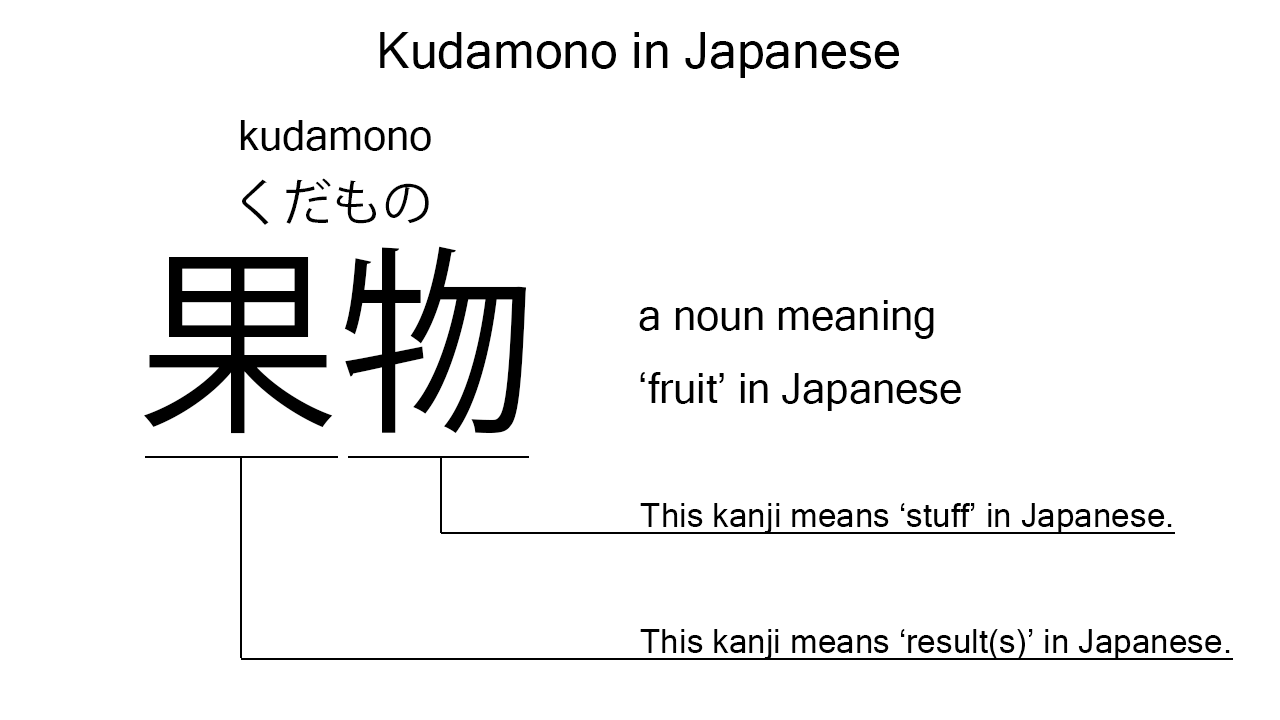What does “kudamono” mean in Japanese?
Native speakers say “kudamono” to mean ‘fruit’ in Japanese. Perhaps, some Japanese learners know this word as it is sometimes used in Japanese conversations. In this blog post, however, I will explain this word in detail based on its kanji expression. And also, I will explain how to use it through example sentences. My explanations would help Japanese learners understand “kudamono” more clearly. Then, let’s get started!
Contents
Definition and meaning of “kudamono”
Let me start with the definition and meaning of “kudamono”.
- kudamono – 果物 (くだもの) : a noun meaning ‘fruit’ in Japanese.
The definition and meaning are simple and clear. To understand this noun more clearly, however, let me explain its kanji characters in detail, one by one.
What does “kudamono” literally mean in Japanese?
The kanji expression of “kudamono” consists of the following two kanji characters:
- 果 : a kanji character used to mean ‘result’, ‘outcome’, or ‘fruit’ in Japanese.
- 物 : a kanji character used to mean ‘thing’, ‘matter’, or ‘stuff’ in Japanese. Depending on the words used together, this can also mean ‘something’ or ‘anything’.
From these two kanji characters, we can understand that “kudamono” literally means a ‘result and stuff’ in Japanese. This literal interpretation is not in line with the actual meaning, but still understandable, I think. In Japanese, we can consider fruit as a result and stuff of growth of plants.

When we meet new kanji expressions, we should check their kanji characters in detail to understand their meanings clearly and deeply. In many cases, kanji characters tell us a lot about the meanings of the expressions they form. Actually, here, we could get the better understanding of “kudamono” through the detailed kanji check above.
So far, I’ve explained the definition and meaning of “kudamono” together with its kanji characters. Then, let me explain how to use it through the example sentences below.
Example #1: how to say “fruit” in Japanese
boku wa kudamono ga totemo suki desu – 僕は果物がとても好きです (ぼくはくだものがとてもすきです)
I love fruit so much.
Below are the new words used in the example sentence.
- boku – 僕 (ぼく) : a pronoun meaning ‘I’ in Japanese. This is used mainly by boys and young males.
- wa – は : a binding particle working as a case marker or topic marker. In the example, this works after “boku” to make the subject in the sentence.
- ga – が : a case particle used to make the subject word or the object word in a sentence. In the example, this is used after “kudamono” to make the object in the sentence.
- totemo – とても : an adverb of degree meaning ‘very’, ‘much’, ‘so’, or such in Japanese. In the example, this works in front of “suki” to emphasize its meaning.
- suki – 好き (すき) : the stem part of the na-adjective, “sukina”, which means ‘favorite’ in Japanese. Native speakers, however, often use this as an individual word to mean ‘to like’ or ‘to love’ in Japanese. In the example, this is used to mean ‘to love’.
- desu – です : an auxiliary verb used after a noun or adjective to make it polite. Probably, this is well known as a part of Japanese desu form. In the example, this is used after “suki” to make it sound polite.
This is a typical usage of “kudamono”. In this example, it works together with the case particle, “ga”, to become the object in the sentence.
Example #2: another usage of “kudamono”
kudamono wa kenkou ni ii – 果物は健康に良い (くだものはけんこうにいい)
Fruit is good for health.
Below are the new words used in the example sentence.
- kenkou – 健康 (けんこう) : a noun meaning ‘health’ in Japanese.
- ni – に : a case particle used to say in which direction a description is directed. In the example, this is used after “kenkou” to indicate the object which fruit is good for.
- ii – 良い (いい) : an i-adjective meaning ‘good’ in Japanese.
This is another typical usage of “kudamono”. In this example, it works together with the binding particle, “wa”, to become the subject in the sentence. When we want to mean ‘fruit’ in Japanese, anyway, this noun is always a very good option.
Summary
In this blog post, I’ve explained the definition and meaning of “kudamono” in detail based on its kanji expression. And also, I’ve explained how to use it through the example sentences. Let me summarize them as follows.
- kudamono – 果物 (くだもの) : a noun meaning ‘fruit’ in Japanese. These two kanji characters literally mean a ‘result and stuff’ in Japanese. This literal interpretation is not in line with the actual meaning, but still understandable, I think. In Japanese, we can consider fruit as a result and stuff of growth of plants.
Hope my explanations are understandable and helpful for Japanese learners.